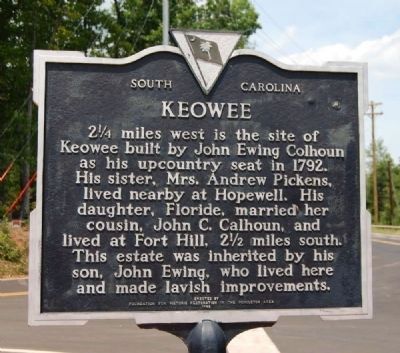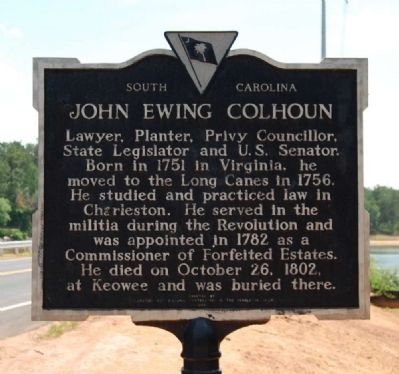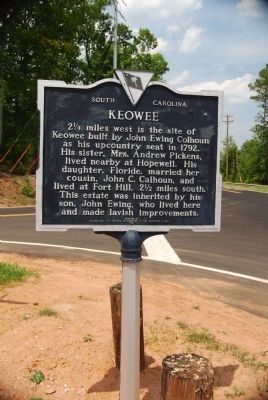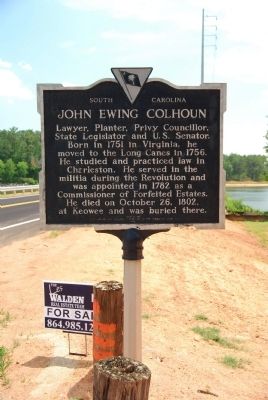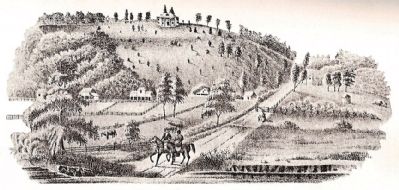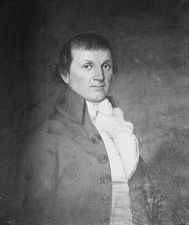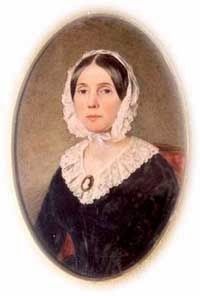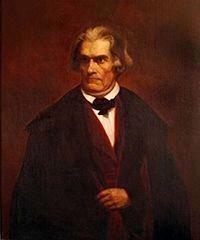Clemson in Pickens County, South Carolina — The American South (South Atlantic)
Keowee / John Ewing Colhoun
Lawyer, Planter, Privy Councillor,
State Legislator and U.S. Senator.
Erected 1966 by Foundation for Historic Restoration in the Pendleton Area. (Marker Number 39-5.)
Topics. This historical marker is listed in these topic lists: Colonial Era • Government & Politics • Settlements & Settlers • War, US Revolutionary. A significant historical month for this entry is October 1967.
Location. 34° 42.899′ N, 82° 49.851′ W. Marker is in Clemson, South Carolina, in Pickens County. Marker is at the intersection of Six Mile Highway (State Highway 133) and Old Six Mile Road, on the left when traveling north on Six Mile Highway. Touch for map. Marker is in this post office area: Clemson SC 29631, United States of America. Touch for directions.
Other nearby markers. At least 10 other markers are within 3 miles of this marker, measured as the crow flies. Calhoun - Clemson School (approx. 1.8 miles away); Mell Hall (approx. 2.3 miles away); And Then There Was War (approx. 2.3 miles away); Holtzendorff Hall (approx. 2.4 miles away); Clemson Cannons (approx. 2.4 miles away); Godfrey Hall (approx. 2.4 miles away); Clemson Military Heritage (approx. 2.4 miles away); Military Heritage Plaza (approx. 2.4 miles away); These Gates (approx. 2.4 miles away); Clemson University (approx. 2.4 miles away). Touch for a list and map of all markers in Clemson.
Also see . . .
1. John Ewing Colhoun. John Ewing Colhoun (1750 – October 26, 1802) was a United States Senator and lawyer from South Carolina. (Submitted on July 25, 2008, by Brian Scott of Anderson, South Carolina.)
2. John Ewing Colhoun (1749-1802) - Find-a-Grave. United States Senator from South Carolina, 1801-1802. (Submitted on December 27, 2011, by Brian Scott of Anderson, South Carolina.)
3. Floride Calhoun. Floride Bonneau Calhoun (February 15, 1792 – July 25, 1866) was the wife of prominent U.S. politician John C. Calhoun. (Submitted on December 27, 2011, by Brian Scott of Anderson, South Carolina.)
4. John C. Calhoun. John Caldwell Calhoun (March 18, 1782 – March 31, 1850) was a leading politician and political theorist from South Carolina during the first half of the 19th century. (Submitted on December 27, 2011, by Brian Scott of Anderson, South Carolina.)
5. Fort Hill. Fort Hill, also known as the John C. Calhoun Mansion and Library, is a National Historic Landmark in South Carolina which was once the home of John C. Calhoun. (Submitted on December 27, 2011, by Brian Scott of Anderson, South Carolina.)
6. Fort Hill: Home of John C. Calhoun and Thomas G. Clemson. Fort Hill was the home of John C. Calhoun, South Carolina’s pre-eminent 19th century statesman, from 1825 until his death in 1850. (Submitted on December 27, 2011, by Brian Scott of Anderson, South Carolina.)
7. Colhoun Family Cemetery, Pickens County, SC. The names of the homes and plantations in the early to mid-nineteenth century on and around the Clemson Experimental Forest evoke a story of grandeur. (Submitted on July 5, 2009, by Brian Scott of Anderson, South Carolina.)
Additional commentary.
1. Facts About Keowee and John Ewing Colhoun
— Submitted December 27, 2011, by Brian Scott of Anderson, South Carolina.
2. Keowee
The only information regarding the appearance of Keowee comes from Keowee Waltzes, composed by Martha Calhoun, daughter of John Ewing Colhoun. Martha pictures the home as being a splendid example of the large, southern, Colonial type of architecture, with tall columns supporting the entrance portion. Brick used in construction was brought from England. The handrails of the stairway were of ebony brought from the west Indies. Colhoun enjoyed shooting and collected guns, which he kept in a favorite cabinet in his study.
From the portico one could look down upon the famous stables and racetrack in the bottoms below the house. Here John Ewing Colhoun bred and raced his thoroughbreds, and here, the favorites were shod with silver. Racing his favorite horses, always ridden by his chosen race-rider, was his passion.
John Ewing Colhoun's wife was the sister of Warren F. Davis, and the considerable fortune she brought into the marriage enabled her husband to indulge in the luxuriate mode of living for which he was noted. The extensive entertaining at Keowee is said to have been extremely lavish, with many African Americans on the plantation dressed in satin liveries to wait upon the important guests of the house. (Source: Tales from the South Carolina Upstate: Where the Cotton & Peaches Grow by Nancy Rhyne (2007) pg 23.)
— Submitted July 5, 2009, by Brian Scott of Anderson, South Carolina.
3. Keowee
Probably the most elaborate plantation home in the district was Keowee, originally the summer home of United States Senator John Ewing Colhoun and his wife, Floride Bonneau Colhoun. It later became the residence of their son, Colonel John Ewing Colhoun, Jr., brother of Mrs. John C. Calhoun. The imposing white frame house has a circular portico supported by tall, stately
columns. It stood on a high hill overlooking the headwaters of the Seneca River. In the spring, when hundreds of white dogwoods bloomed on the grounds, Keowee was a scene of enchanting beauty.
Colonel Colhoun was an able financier and served at one time as state treasurer. Negroes who worked on the plantation supposedly said that Colhoun was so rich he shod his horses with silver horseshoes. The extensive plantation included a small cloth-making plant. (Source: The Pendleton Legacy by Beth Ann Klosky, pg 53.)
Sadly, in the late 1920s or early 1930s a fire destroyed the house. However, the remnants of Keowee provide a point of special interests in the Clemson forest. The house is represented by foundation works and is surrounded by a diverse assortment of mature trees. In the valley across the road are the remains of the spring house, and on a nearby hill is the family cemetery where John Ewing Colhoun and his family are buried. (Source: Quiet Reflections: The Clemson University Forest by John S. Garton and C. Thomas Wyche (2007).)
— Submitted July 5, 2009, by Brian Scott of Anderson, South Carolina.
4. John Ewing Colhoun (1749-1802)
John Ewing Colhoun, (cousin of John Caldwell Calhoun and Joseph Calhoun), a Senator from South Carolina; born in
Staunton, Augusta County, Va., around 1749; attended the common schools and graduated from the College of New Jersey (now Princeton University) in 1774; member, State house of representatives 1778-1800; studied law; admitted to the bar in 1783 and commenced practice in Charleston, S.C.; farmer; elected a member of the privy council and also a commissioner of confiscated estates in 1785; member, State senate 1801; member of the committee which was instructed to report a modification of the judiciary system of the United States; elected as a Democratic Republican to the United States Senate and served from March 4, 1801, until his death in Pendleton, S.C., October 26, 1802; interment in the family cemetery, Old Pendleton District, now Pickens County, S.C. (Source: Biographical Directory of the U.S. Congress.)
— Submitted July 5, 2009, by Brian Scott of Anderson, South Carolina.
5. John Caldwell Calhoun (1782 - 1850)
John Caldwell Calhoun, (cousin of John Ewing Colhoun and Joseph Calhoun), a Representative and a Senator from South Carolina and a Vice President of the United States; born near Calhoun Mills, Abbeville District (now Mount Carmel, McCormick County), S.C., March 18, 1782; attended the common schools and private academies; graduated from Yale College in 1804; studied
law, admitted to the bar in 1807, and commenced practice in Abbeville, S.C.; also engaged in agricultural pursuits; member, State house of representatives 1808-1809; elected as a Democratic Republican to the Twelfth and to the three succeeding Congresses and served from March 4, 1811, to November 3, 1817, when he resigned; Secretary of War in the Cabinet of President James Monroe 1817-1825; elected vice president of the United States in 1824 with President John Quincy Adams; reelected in 1828 with President Andrew Jackson and served from March 4, 1825, to December 28, 1832, when he resigned, having been elected as a Democratic Republican (later Nullifier) to the United States Senate on December 12, 1832, to fill the vacancy caused by the resignation of Robert Y. Hayne; reelected in 1834 and 1840 and served from December 29, 1832, until his resignation, effective March 3, 1843; Secretary of State in the Cabinet of President John Tyler 1844-1845; again elected to the United States Senate, as a Democrat, to fill the vacancy caused by the resignation of Daniel E. Huger; reelected in 1846 and served from November 26, 1845, until his death in Washington, D.C., March 31, 1850; chairman, Committee on Finance (Twenty-ninth Congress); interment in St. Philip’s Churchyard, Charleston, S.C. (Source: Biographical Directory of the U.S. Congress.)
— Submitted December 28, 2011, by Brian Scott of Anderson, South Carolina.
Credits. This page was last revised on June 30, 2022. It was originally submitted on July 25, 2008, by Brian Scott of Anderson, South Carolina. This page has been viewed 2,513 times since then and 79 times this year. Photos: 1, 2. submitted on July 5, 2009, by Brian Scott of Anderson, South Carolina. 3, 4. submitted on July 25, 2008, by Brian Scott of Anderson, South Carolina. 5, 6. submitted on July 5, 2009, by Brian Scott of Anderson, South Carolina. 7, 8. submitted on December 27, 2011, by Brian Scott of Anderson, South Carolina. • Craig Swain was the editor who published this page.
